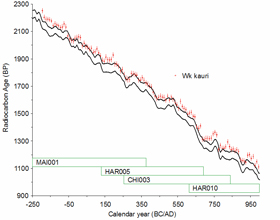Southern Hemisphere Radiocarbon Calibration

14C measurements from dendrochronologically-dated New Zealand kauri; overlain by the Northern hemisphere calibration curve (IntCal09).
Radiocarbon (or 14C) dating is the most widely used tool for helping to define geological, palaeoenvironmental, and archaeological events over the last 60,000 years. For example in New Zealand, 14C dates on wood and peat trace the spread or contraction of forests and glacial advances and retreats in response to global climate change; marine shell dates document the development of beach ridges, estuaries and harbours formed as a result of sea-level rise and fall; charcoal dates measure the timing of volcanic eruptions; and shell, bone and charcoal dates mark the arrival and dispersion of humans and their impact upon the environment.
The atmospheric 14C concentration has varied through time due to cosmic ray fluctuations. This means that 14C dates do not equate directly with calendar time and therefore must be corrected using a calibration curve (constructed by 14C dating of samples of known calendar age). The material of choice for the construction of a calibration curve is wood whose calendar age has been determined precisely by tree ring counting (dendrochronology).
Southern Hemisphere samples have a lower 14C content than contemporaneous Northern Hemisphere material – referred to as the 14C interhemispheric offset which varies over time. This obviously has important ramifications for any Southern Hemisphere carbon dating, particularly for studies of climate change, the timing of natural disasters, and anthropogenic effects.